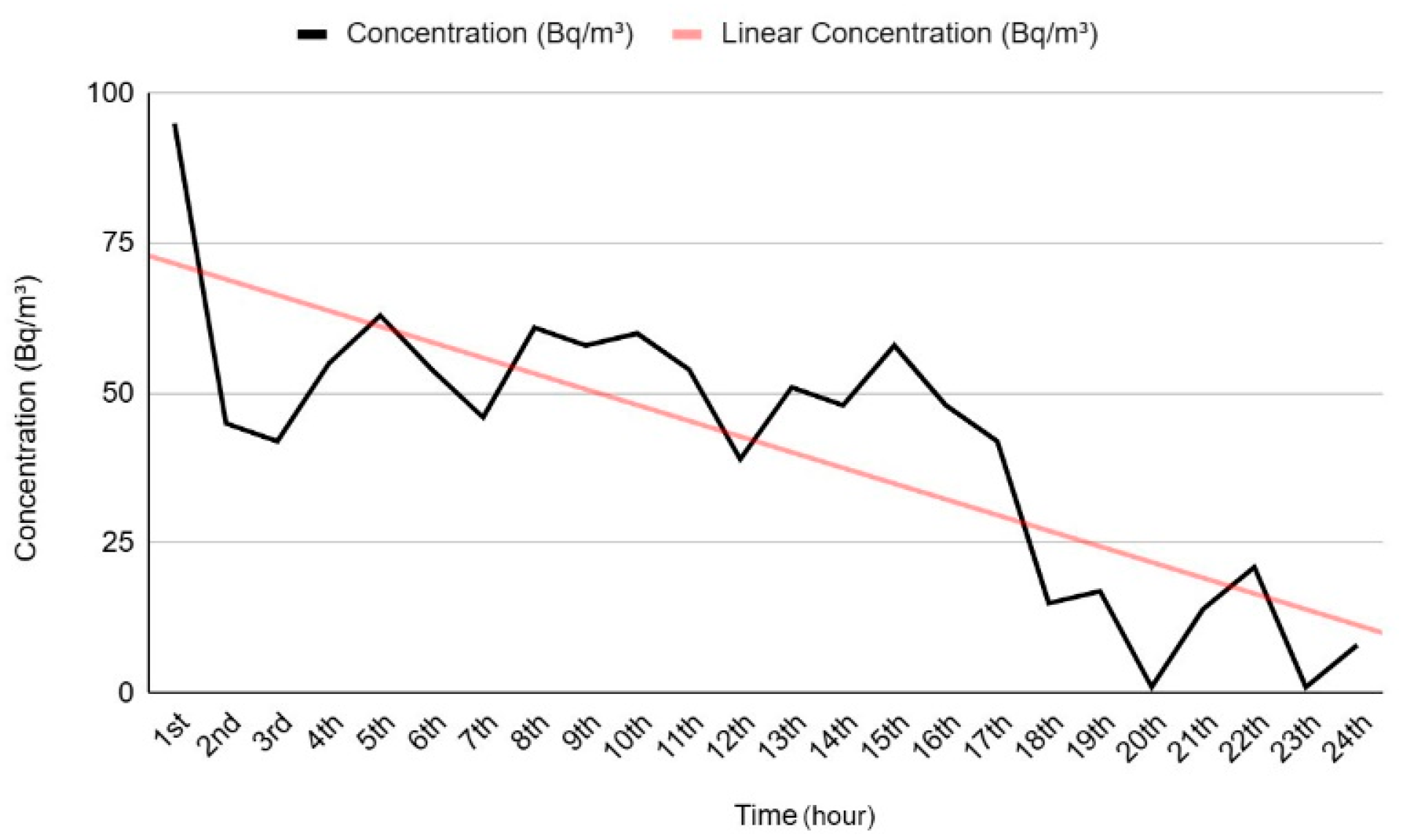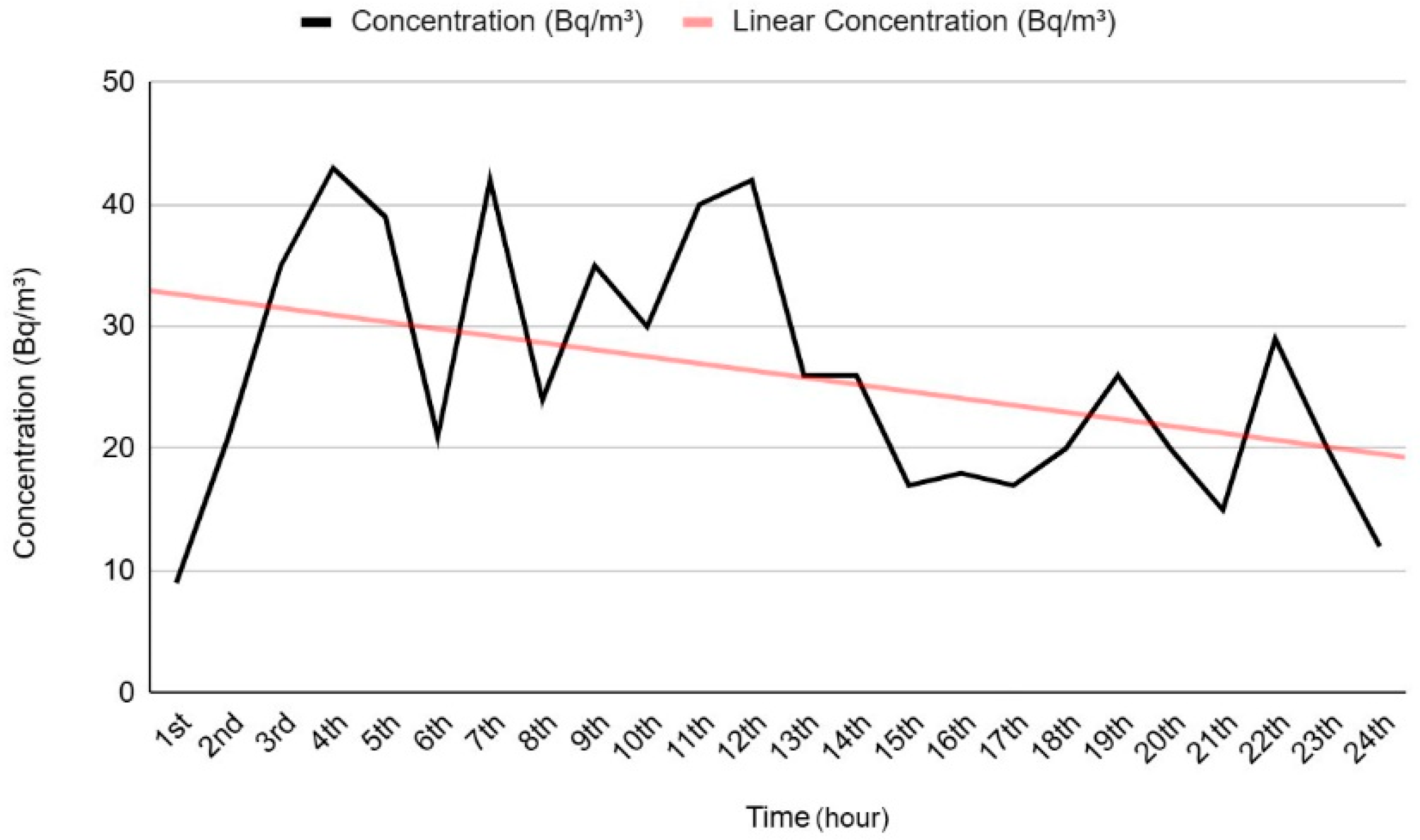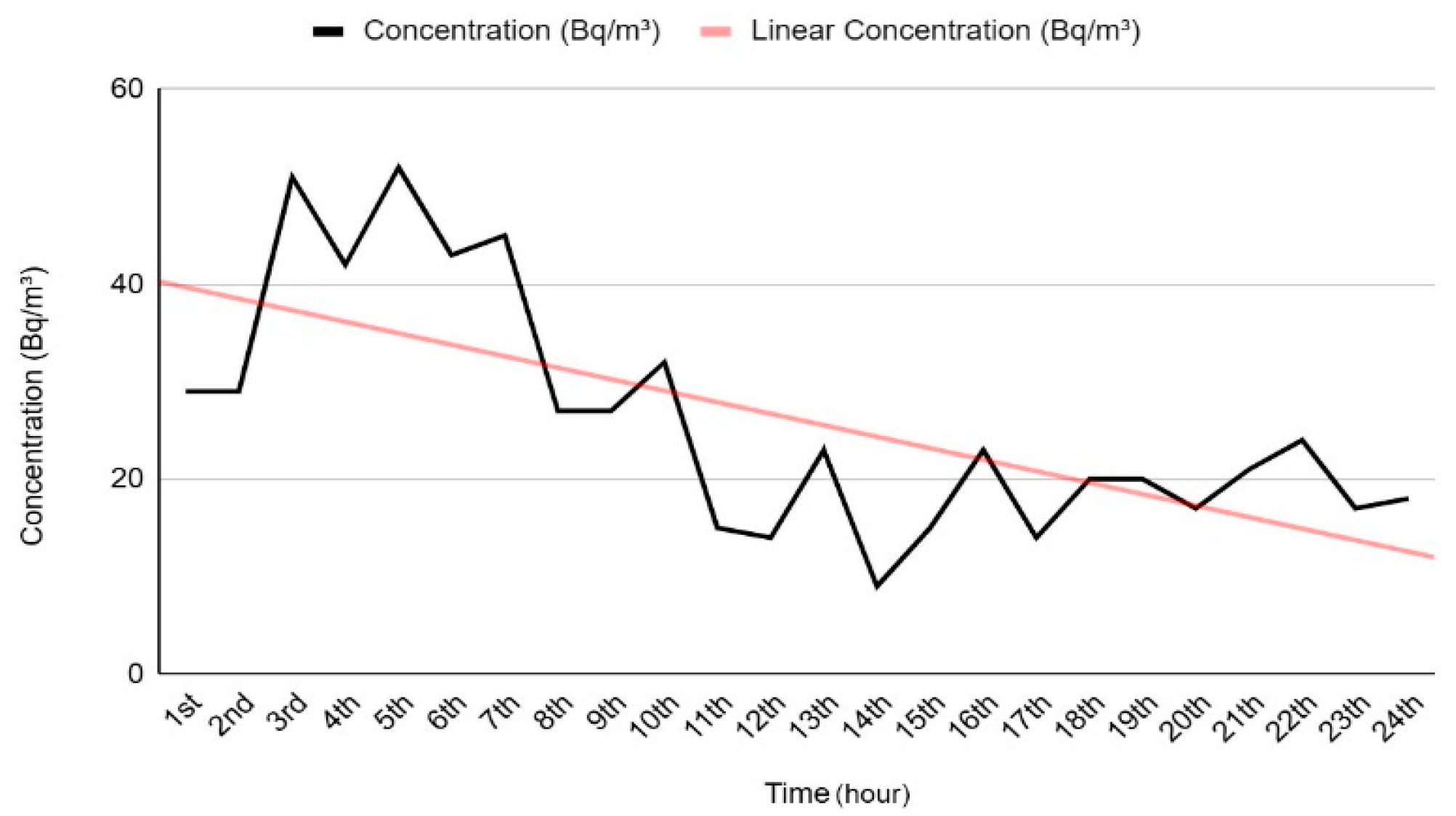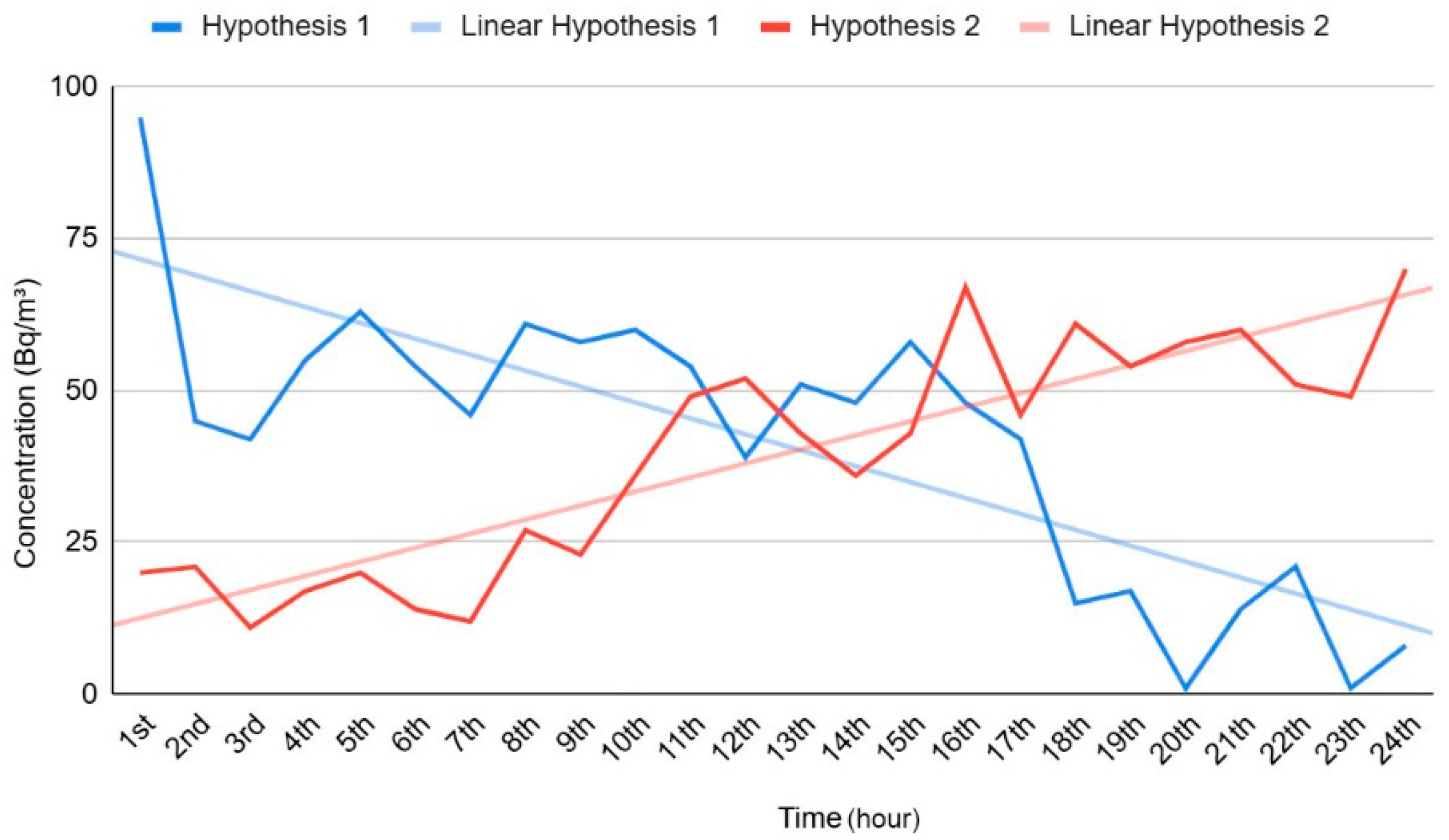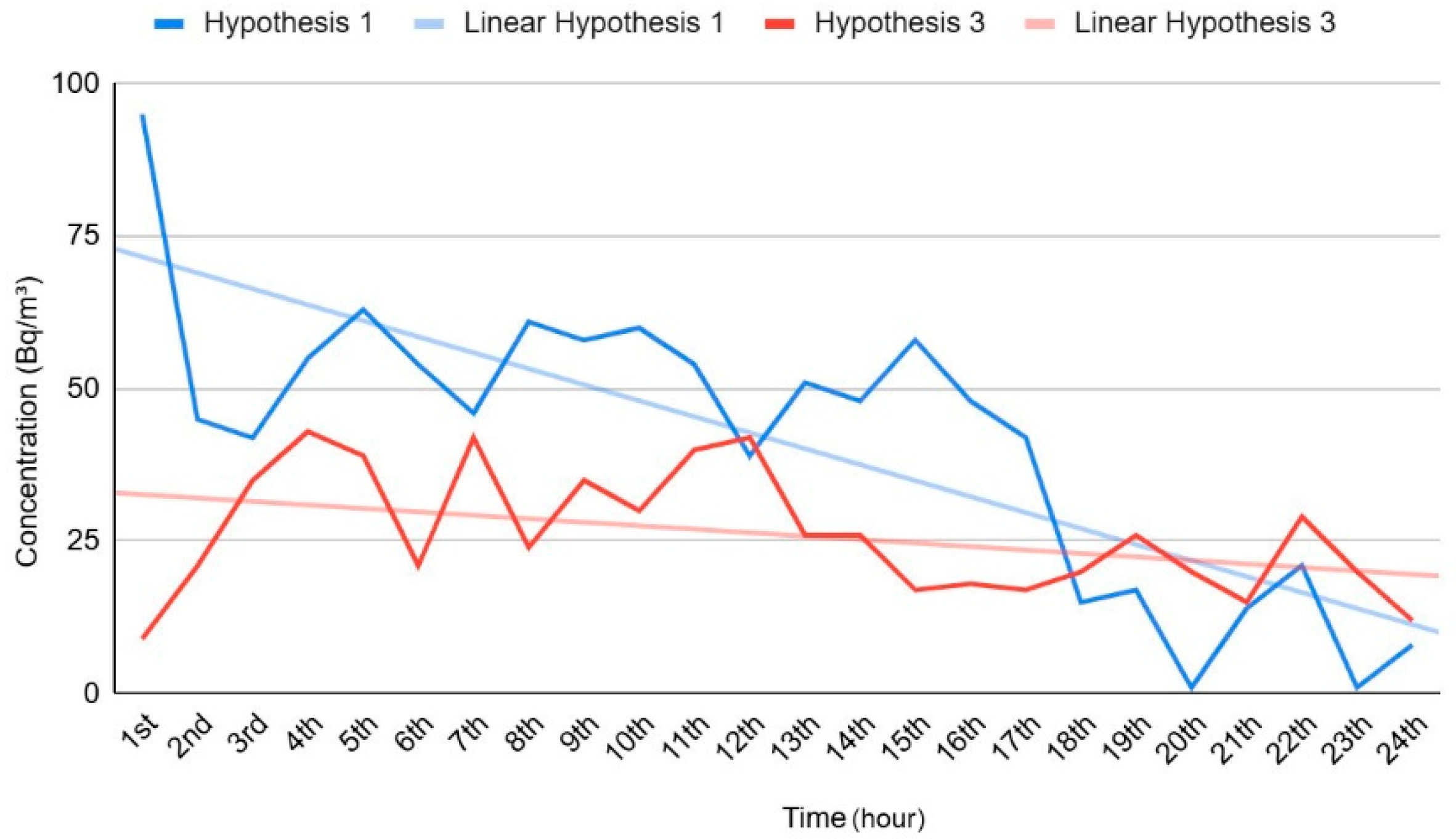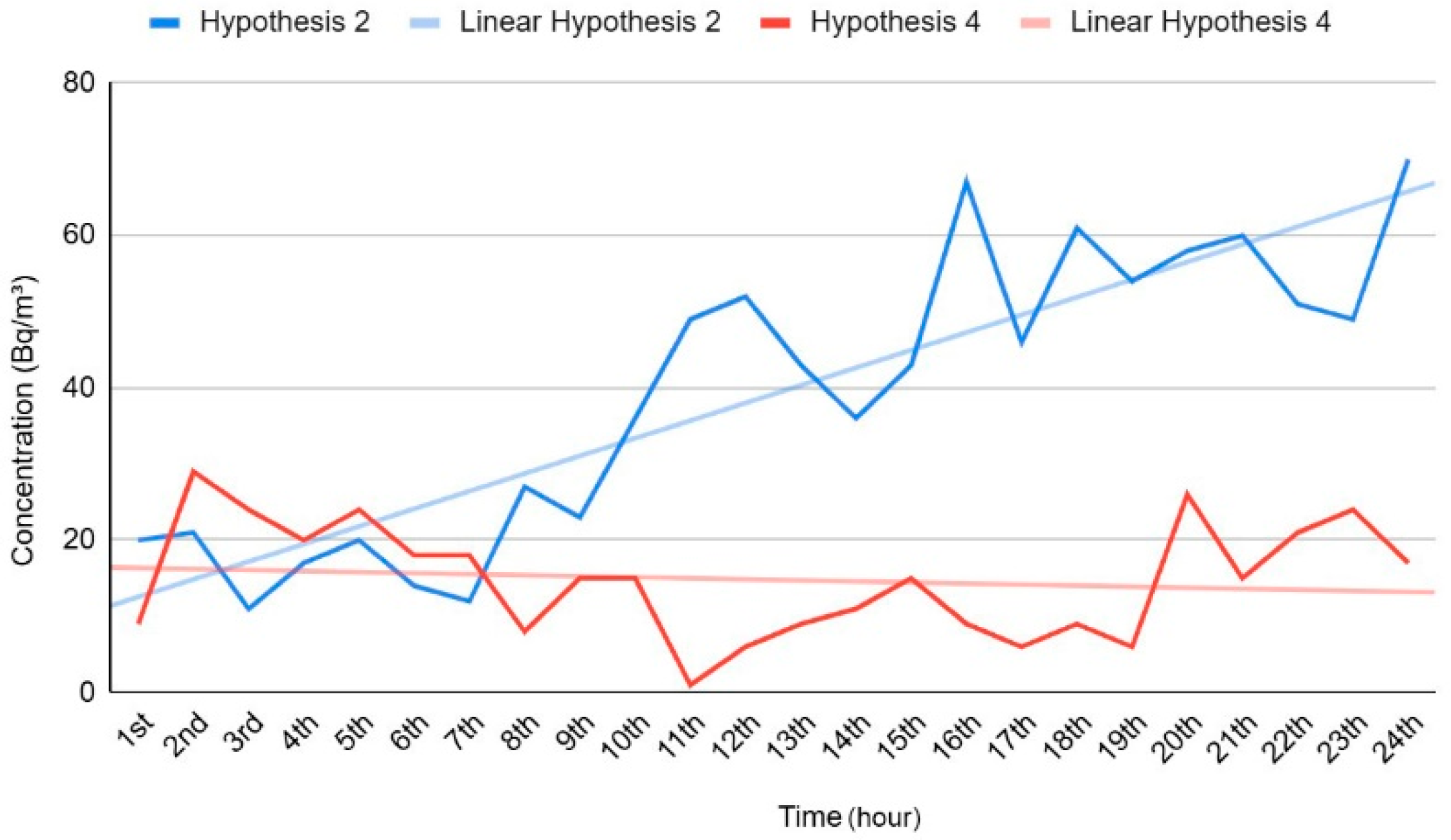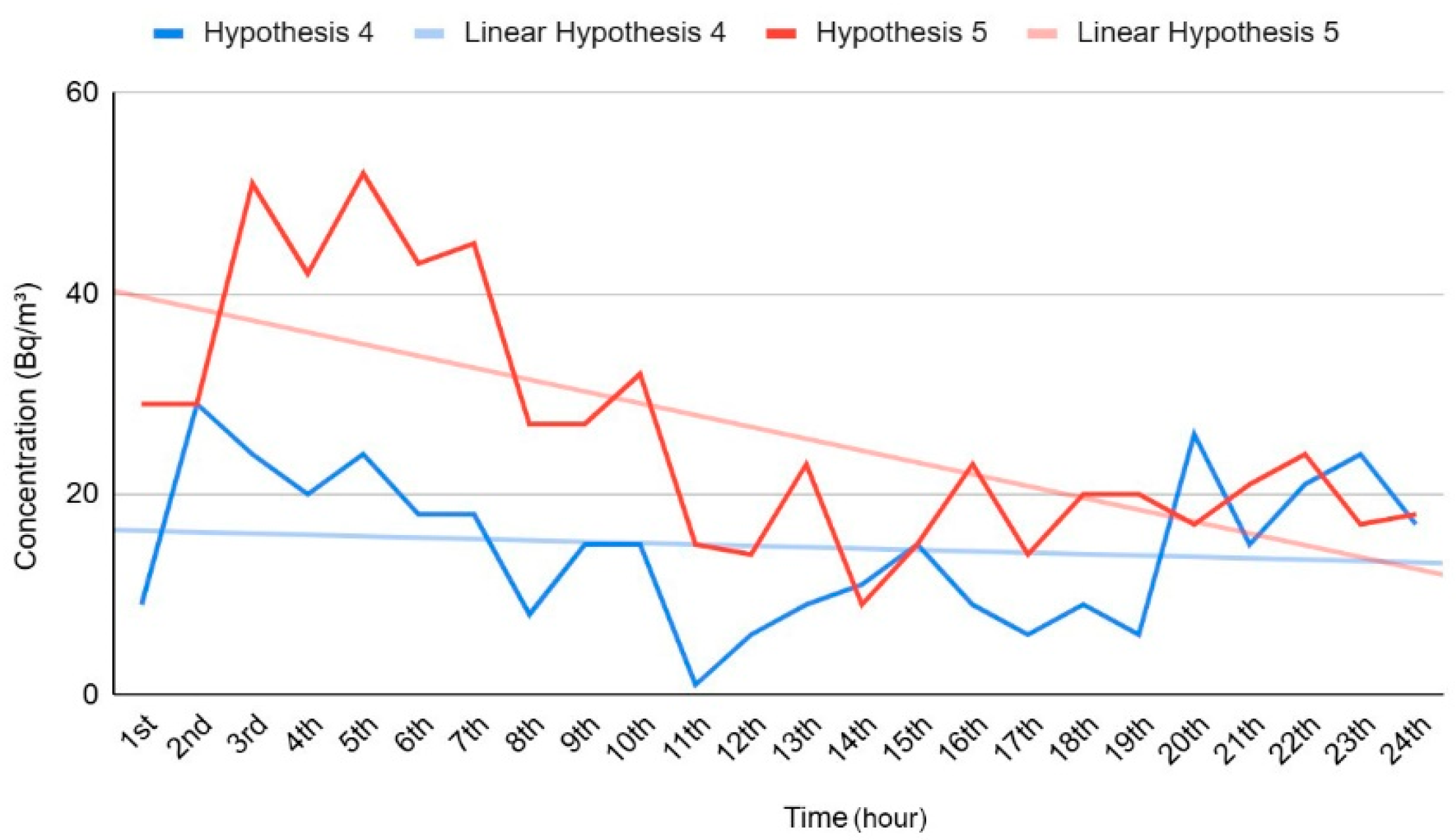1. Introduction
As the fifth most abundant gas in the Earth’s crust, radon (Z = 86) is a noble gas and has been identified as a major source of indoor radiation exposure [
1]. It has been established by the World Health Organization that radon is the second most significant cause of lung cancer next to smoking [
2]. This is due to the fact that people spend a significant amount of their time indoors, thus it is important to assess the concentration of radon in residential and occupational areas for public health purposes [
3].
There are two isotopes of radon, namely,
222Rn (from the uranium-238 decay chain via the
226Ra channel) and
220Rn, also referred to as thoron from the thorium-232 decay chain via the
224Ra channel [
4]. The half-lives of these two isotopes are 3.8 days for
222Rn and 55 s for
220Rn, which have a significant impact on their distribution in the environment [
4]. Due to its inert nature, radon is emitted from solid matrices like soil, rocks, and building materials and is transported in the subsurface as a carrier gas (e.g., CO
2) or through groundwater [
5].
The rates of radon emission vary significantly and are influenced by temperature, humidity, porosity, and the mineral composition of soil and rock. The emission coefficients for soil and rock are between 0.1% and 40% [
6]. The main sources of radon in homes are as follows:
From the ground and the rocks under the buildings, where the gas enters through cracks, joints, and around pipes. It is most dangerous in basements and cellars.
Construction materials, especially those that are naturally mineral based. In temperate climates, the indoor radon concentration from these materials can account for as much as 20% of the total radon concentration in homes [
2].
Domestic water supplies, where radon dissolved in groundwater, are released when household activities such as showering take place, thereby increasing the concentration of radon in the air locally [
2].
As suggested by the WHO, to prevent the health risks to a maximum annual average indoor radon level of 100 Bq/m
3, it is possible to determine the level of radon using the active methods (alpha spectrometry) or the passive methods (activated carbon detectors) [
7].
As far as the reduction in indoor radon pollution is concerned, it is a big problem. The two major methods of reducing the levels of indoor radon are as follows: (1) reducing the entry of radon into buildings and (2) increasing the rate of air exchange in the indoor environment [
8]. To reduce entry from soil and rock interstitial air, a barrier that is impermeable can be placed between the ground and the building foundation. Such methods of sub-slab depressurization systems or other active soil suction techniques can remove radon before it enters the interior space [
3,
9].
Ventilation works best to reduce radon emissions from building materials and domestic water sources. The combination of natural and mechanical ventilation systems works well to prevent radon accumulation in warm climates. The requirement for energy efficiency in cold climates necessitates mechanical ventilation systems to bring fresh radon-free air into buildings while removing radon-contaminated air [
10].
The human body absorbs radon and its short-lived decay products mainly through inhalation and consumption while exposing individuals to serious health threats. Prolonged radon exposure at elevated levels within unventilated houses leads to an increased risk of developing lung cancer [
11]. Radon creates no environmental compounds because it is a noble gas and does not bind to microbes or plants or sediments, which enables it to easily move from its formation locations into the atmosphere [
12].
The process of radon formation takes place within soil mineral grains or organic matter before it diffuses into adjacent air-filled and water-containing pore spaces. According to Henry’s law, soil water and air partition before radon diffuses to the surface through either advective flow or diffusion based on soil permeability [
13]. The movement of radon from its source can reach distances of hundreds of kilometers [
6,
14].
Underneath buildings, radon continues to form constantly in the underlying soil. Radon can easily move into indoor areas because even the slightest negative indoor pressure allows it to pass through foundation cracks, joints, and pipe penetrations [
3]. The concentrations of radon indoors become hundreds of times greater than outdoor radon levels [
15]. Workers in underground workplaces face additional exposure dangers because of inadequate ventilation and proximity to radon emission sources. The process of water consumption leads to the release of dissolved radon into indoor air [
11].
According to the United Nations Scientific Committee on the Effects of Atomic Radiation (UNSCEAR), radon stands as the leading cause of natural radiation exposure affecting both workers and general population members [
11]. The radiation dose received by mine workers comes mostly from radon which comprises about 80% [
16]. The general population receives about 50% of their natural radiation exposure from radon present in indoor air. Finland stands out as a country where indoor radon exposure creates more than half of total radiation doses that exceed medical, industrial and nuclear fallout contributions [
11]. The exposure of people who consume radon-rich borehole water reaches elevated levels because this group makes up only 4% of the total population [
17]. Radiation protection authorities worldwide recognize radon mitigation and public protection as their top priorities because of health concerns and exposure risks.
3. Results
To confirm the hypotheses developed in the previous section, a series of data-driven investigations were carried out using radon measurements collected over a specific period. The measurements presented in the following figures do not represent isolated single-day events. Instead, each figure illustrates an indicative day from the 150-day dataset, based on the observation that these radon concentration patterns occurred repeatedly under similar environmental and operational conditions. Changes in radon concentration during these days were graphically depicted in 24 h cycles. The study focuses on identifying trends, such as the effect of human activity on air circulation, the relationship between heating system operation and radon levels, and the role of ventilation in reducing indoor radon accumulation. Each graph depicts how radon behaves under various conditions, allowing for comparison of different factors that affect it.
The purpose of these diagrams is to assess whether the hypotheses are accurate. The findings will serve as a foundation for the evaluation and conclusions in the next section, where each hypothesis will be assessed for its validity and implications.
The measurements in
Figure 1 show that radon concentrations reach their highest levels during the first part of the day. The concentrations decrease gradually after reaching their peak levels in a pattern that matches the linear trend. The radon accumulation at the beginning of the day occurs because the space remains sealed and air exchange rates decrease during nighttime.
The day-by-day reduction in concentrations occurs because brief ventilation episodes and indoor condition modifications enable gas removal. The high initial radon concentrations support the hypothesis that cold temperatures allow for radon accumulation because low outdoor temperatures restrict ventilation and create pressure differences that influence radon transport into buildings.
The collected data confirms that radon concentrations rise on cold days, thereby requiring proper ventilation and indoor air quality control measures.
The graph in
Figure 2 shows radon concentration rising steadily throughout the day, while the linear trend shows a positive slope. The observed radon concentration rise matches the hypothesis that reduced air exchange and limited activity, as well as no ventilation during holidays cause radon to build up in indoor spaces.
The concentration shows occasional variations which could stem from brief changes in air circulation patterns or environmental elements. The overall upward trend indicates that both human inactivity and restricted air renewal play essential roles in raising radon concentrations.
These data validate the hypothesis about low activity periods resulting in radon accumulation, which supports the requirement for proper ventilation systems during periods of reduced human occupancy.
The diagram in
Figure 3 shows a general decrease in concentration throughout the day through its linear trend. The observed radon concentration decrease may result from the establishment of a dynamic equilibrium between radon concentration and air exchange or modifications in heating operations during daytime hours.
The observed time period shows that warming onset leads to short-term radon concentration increases which align with the hypothesis predictions. Additional research along with environmental and operational factor analysis are needed to determine the specific cause of these concentration variations.
The relationship between human activity and radon concentration shows variations through
Figure 4, which presents radon level changes during a busy day. According to Hypothesis 4, the combination of more activity and better ventilation helps decrease radon concentration through improved air circulation.
The radon concentration shows distinct changes throughout the day with rising and falling patterns. The minimum radon values appear at various times because continuous air movement creates conditions that decrease radon concentrations inside the building space. The highest radon readings appear at times when ventilation decreases, or air circulation stops.
The diagram shows a straight line that indicates radon levels decrease briefly during increased activity, but this does not produce a steady downward pattern. The ongoing radon emissions from soil and building materials function as counteracting factors that prevent ventilation from eliminating radon presence.
The analysis of data reveals that human activity together with ventilation affect radon concentration, but the effect remains partial. The data supports Hypothesis 4 because radon concentration decreases, but the evidence does not show enough support to prove that ventilation eliminates radon from the indoor space.
As
Figure 5 indicates, the radon concentrations begin the 24 h period at elevated levels, which show multiple fluctuations because the gas accumulated during hours with minimal ventilation. The initial peaks in radon concentration appear because ventilation remains poor, and air stagnates within indoor spaces.
The radon concentration decreases steadily throughout the day because human activity increases and natural or artificial ventilation becomes more effective. The downward trend shown in the dotted line demonstrates that radon concentration levels decrease throughout the day.
The middle section of the 24 h period shows minor variations because air circulation patterns might shift, or heating and air conditioning systems could be operating. The values show stabilization or a minor increase during the last part of the period because ventilation decreases during evening hours.
The diagram supports the investigated hypothesis by demonstrating that radon concentrations increase at night because of poor ventilation, while they decrease throughout the day because of better air circulation.
The following correlations focus on the most significant and conceptually linked hypotheses. The ones selected highlight the major environmental and operational factors influencing radon behavior.
The correlation analysis presented in
Figure 6 demonstrates opposing patterns between the two hypotheses regarding radon concentrations. The first hypothesis proposes that radon levels increase on colder days because ventilation decreases, and temperature differences become more pronounced. The second hypothesis states that radon accumulation rises during holidays because the air remains stagnant.
The graphical illustration demonstrates that the first hypothesis curve decreases, which suggests radon concentration levels decrease because of enhanced air exchange throughout the day. The second hypothesis curve demonstrates an upward direction, which shows that radon concentrations rise when human activities decrease.
The opposing patterns between these two mechanisms could be caused by different factors that affect radon concentration levels. The gas retention indoors becomes more effective during cold temperatures and ventilation limitations during off-season periods lead to increased gas concentration. The different trends between these two hypotheses indicate that understanding radon accumulation requires analyzing temperature and ventilation conditions together.
The connection between Hypotheses 1 and 3 investigates the relationship between temperature fluctuations and heating system operation on radon concentration levels. Hypothesis 1 predicts that radon concentrations increase when temperatures drop because ventilation decreases, while temperature differences enhance radon gas transport between buildings and the ground. Hypothesis 3 proposes that heating system activation leads to brief radon increases because of air circulation and pressure variations.
The curve of Hypothesis 1 in
Figure 7 demonstrates elevated radon concentrations at the start of the day, which then decreases progressively to show radon accumulation patterns during cold temperatures. The curve of Hypothesis 3 demonstrates minor variations, which represent the impact of heating on gas distribution patterns. The trend lines demonstrate that radon levels rise from both factors; yet, the cold environment maintains stable concentrations while heating produces brief variations.
Low temperatures elevate the standard radon concentration, while heating system activation produces brief peaks because of air circulation and internal pressure variations. The general decline in both cases appears to result from increased daily ventilation or equalization of atmospheric pressure.
The graph in
Figure 8 shows radon concentration measurements between low human activity times and high human activity times with improved ventilation systems. Radon concentration shows a steady rise in the first scenario because of the lack of ventilation and decreased air movement, thereby enabling the gas to build up inside indoor spaces.
The high human activity conditions result in stable and significantly lower radon concentrations, which supports the hypothesis that ventilation together with air mobility work as radon removal systems. The first case shows a linear trend that increases steadily, which supports the idea that enclosed spaces with air will cause radon concentrations to rise continuously.
The analysis of these two hypotheses shows how human activity affects radon levels and proves that ventilation systems, both natural and artificial, play a crucial role in controlling indoor gas concentrations.
The comparison between Hypotheses 3 and 5 in
Figure 9 demonstrates how radon concentration changes when environmental conditions differ. The activation of heating systems under Hypothesis 3 leads to short-term radon level increases because of air recirculation and pressure changes. The fifth hypothesis studies how radon concentrations change throughout the day by showing higher nighttime values because of reduced ventilation and lower daytime values because of increased human activity.
The diagram displays significant changes in radon concentration through its visual presentation of both hypotheses. The early morning hours produce peaks in Hypothesis 5, which matches the theoretical explanation of nighttime radon concentration elevation due to minimal air renewal. The time series data in Hypothesis 3 demonstrates sudden spikes, which support the hypothesis that heating system activation produces these effects.
The two data trend lines demonstrate a general decline in both cases but with different steepness. The observed decrease could stem from ventilation growth alongside the diminishing heating effects that occur after a specific period. The data comparison reveals that the two factors interact because heating-related air recirculation strengthens or transforms the natural daily patterns of radon concentrations.
The analysis of this data confirms that radon concentrations follow dynamic patterns because of thermal and environmental factors which validate both hypotheses.
The data presented in
Figure 10 demonstrates how human activity together with ventilation affect indoor radon concentrations between Hypotheses 4 and 5. According to Hypothesis 4, the combination of human activity and ventilation leads to decreased radon concentrations because it promotes better air circulation. The fifth hypothesis examines diurnal radon variations by showing elevated nighttime radon levels because of decreased ventilation and reduced daytime radon levels because of increased human activity.
The two hypotheses present data patterns that do not match each other well. The initial radon concentration values in Hypothesis 5 decrease gradually throughout the observation period in accordance with the predicted daily pattern. The data distribution in Hypothesis 4 remains stable while showing minimal variations because human activity and ventilation work to keep radon levels low.
The downward trend in both data points exists, but Case 5 demonstrates more significant variations between its values. The data shows that radon levels decrease throughout the day, but there are occasional spikes which could result from changes in ventilation or human activities.
The results validate that human activity and natural ventilation are key to radon removal from indoor environments, although radon concentrations increase at night because of decreased air circulation. Multiple hypotheses comparisons demonstrate that sufficient air replacement emerges as the essential factor for lowering radon concentration.
The evaluation of indoor radon concentration measurements revealed crucial factors, which affect gas behavior and movement patterns in different situations. The systematic evaluation of the proposed hypotheses revealed both correct statements and partial confirmation together with new relationships between variables.
Hypothesis 1. Low Outdoor Temperatures and Radon Levels.
The analysis showed that colder days lead to increased radon levels because ventilation is low, while temperature gradients help radon migration from subsoil into buildings. There were some cases where human presence and sufficient air exchange managed to limit the growth of radon concentrations. This shows that although temperature is an important factor, it is not the only one, and other factors can also play a role.
Hypothesis 2. Low Human Activity and Radon Accumulation.
Research evidence supports the fact that periods with little human interaction like holidays lead to higher radon concentrations. The lack of movement together with the lack of natural ventilation lead to the formation of stagnant air and gas accumulation, which underlines the need for mechanical ventilation systems during such periods.
Hypothesis 3. Heating Systems and Radon Fluctuations.
Data revealed that heating may lead to short-term increases in radon levels possibly because of changes in pressure and air movement. At the same time, there were some cases where heating decreased concentration, possibly because of better circulation. Therefore, the effect of heating is not a consistent factor for increasing or decreasing radon levels, but instead depends on the overall ventilation conditions.
Hypothesis 4. Human Activity and Reduced Radon Levels.
The hypothesis was fully confirmed. The results of the analysis revealed that higher occupancy and natural ventilation led to lower radon levels, which confirms that human activity and frequent air exchange are effectively affecting the reduction in radon levels.
Hypothesis 5. Diurnal Fluctuations in Radon Levels.
Radon concentrations tend to rise at night when ventilation is usually lower and falls during the day when there is more activity and flow. However, this motif was altered sometimes by other affecting elements such as heating or unsteadiness in the occupancy.
The selected hypotheses (H1–H5) show that ventilation and human activity are the most consistent and influential factors in reducing indoor radon concentrations. The accumulation of radon is reduced by low temperatures and reduced occupancy, but this effect is significantly reduced when effective ventilation is present. The heating systems produced variable effects on radon levels, which either increased or decreased based on airflow dynamics. These interactions show the complex but predictable roles of environmental and operational conditions in indoor radon behavior.
